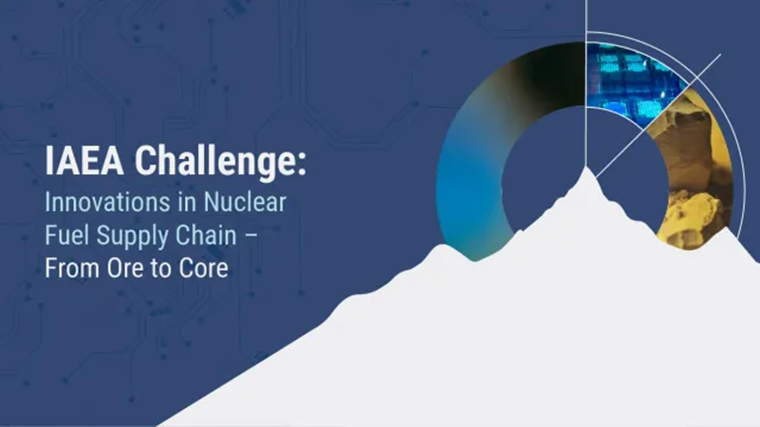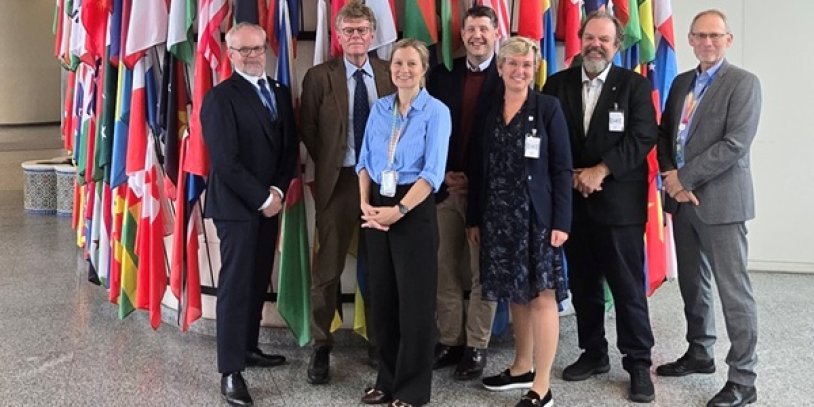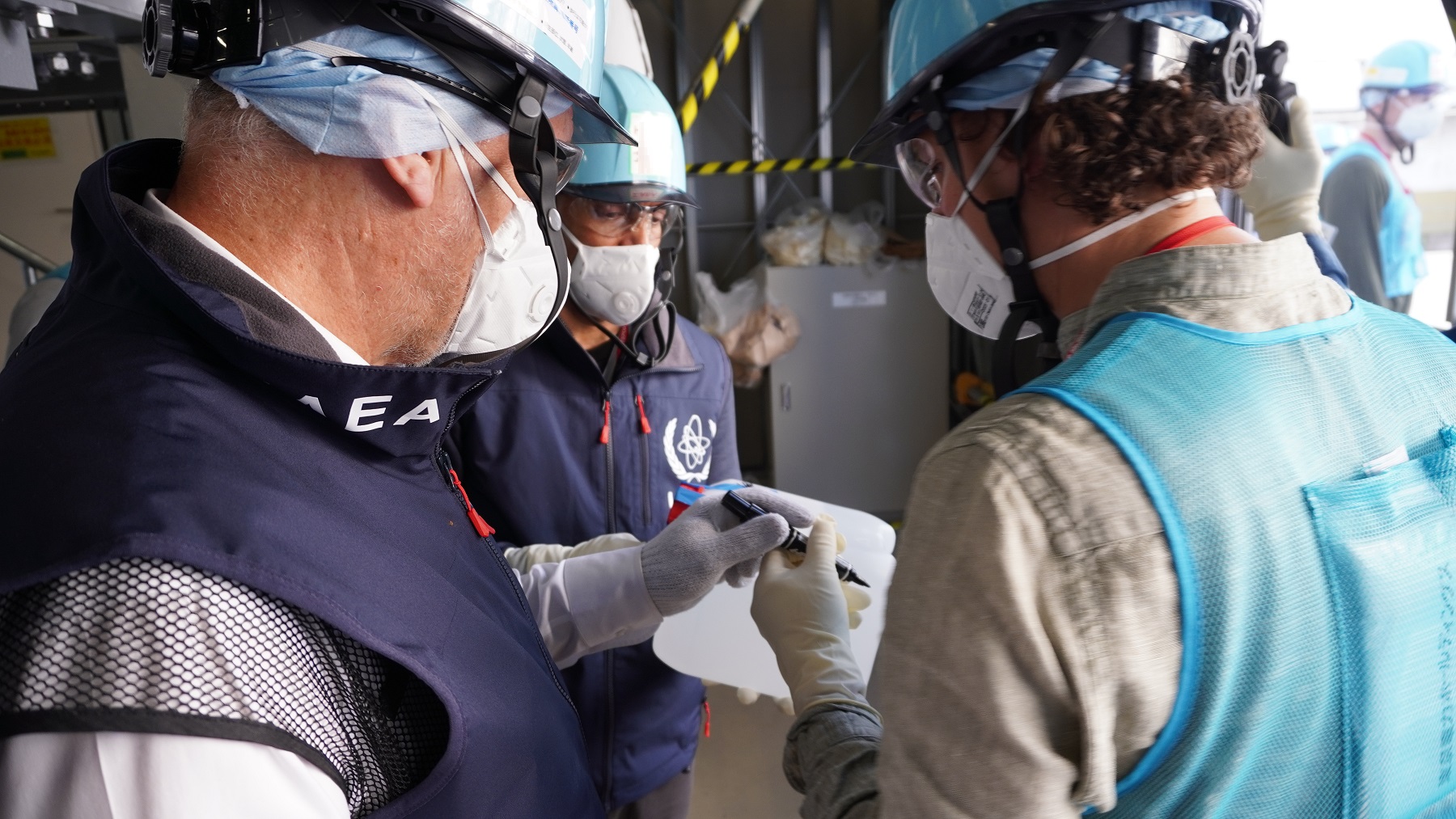From left, Gerald Nieder-Westermann, IAEA waste disposal specialist; Andrea Pigorini, ITA president; Karina Lange, IAEA waste disposal specialist and scientific secretary for the IAEA’s Underground Research Facilities Network, Daniel Garbutt, ITA representative; Helen Roth, ITA executive director; Arnold Dix, ITA past president and chair of the ITA special interest group; and Stefan Joerg Mayer, IAEA team lead. (Photo: ITA)
The International Tunnelling and Underground Space Association (ITA), a nongovernmental organization made up of 81 member states working to advance the safe, beneficial use of subsurface spaces, is working with the International Atomic Energy Agency to support the advancement of geologic disposal facilities for high-level radioactive waste.
Arvin Boolell (facing), Mauritius’s minister of agro-industry, food security, blue economy, and fisheries, is nearly obscured by the Local Cream cauliflower he is inspecting with scientists.
WM Symposia’s Greg Meyer (left) with Mikhail Chudakov from the IAEA. (Photo: WM Symposia)
WM Symposia, which hosts the annual Waste Management Conference in Phoenix, Ariz., announced it has signed a practical arrangement with the International Atomic Energy Agency aimed at strengthening international collaboration in the safe management of radioactive waste, decommissioning, and environmental remediation.
IAEA director general Rafael Mariano Grossi (center right) attends the signing of an agreement by representatives of the EAGLES Consortium and the nuclear regulators of Belgium, Italy, and Romania. (Photo: IAEA)
The nuclear regulators of Belgium, Italy, and Romania signed on this week to the first “prelicensing” project under the IAEA’s Nuclear Harmonization and Standardization Initiative (NHSI) during the opening day of the International Atomic Energy Agency’s 69th General Conference, pledging to work with the EAGLES Consortium to clarify regulatory requirements for a lead-cooled reactor ahead of formal licensing.
Mike Goff (center left), the DOE’s acting assistant secretary for nuclear energy, poses with this year’s ISOP Innovation Award winners. From left, Jim Tusar, Constellation; Pete Mrvos, Blue Waves; Jonathan Nistor, Blue Wave; Aaron Phillippe, Southern Nuclear; and Jeremy Barnhart, Constellation. (Photo: Blue Wave)
The International Atomic Energy Agency presented its 2025 Global ISOP Innovation Award for AI to Blue Wave AI Labs, Constellation, and the Southern Company subsidiary Southern Nuclear for the companies’ collaborative work on Blue Wave's ThermalLimits.ai. The technology is an AI application that provides accuracy in online thermal limit forecasting for boiling water reactors.
IAEA personnel check a sample of Fukushima’s ALPS-treated water. (Photo: TEPCO)
An International Atomic Energy Agency task force has confirmed that the discharge of treated water from Japan’s Fukushima Daiichi nuclear power plant is proceeding in line with international safety standards. The task force’s findings were published in the agency’s fourth report since Tokyo Electric Power Company began discharging Fukushima’s treated and diluted water in August 2023.
More information can be found on the IAEA’s Fukushima Daiichi ALPS Treated Water Discharge web page.
IAEA Marie Sklodowska-Curie Fellowship Program fellows and Lise Meitner Program participants at a 2024 event. (Photo: IAEA)
The application period for the International Atomic Energy Agency’s Marie Sklodowska-Curie Fellowship Program (MSCFP) has opened. Women interested in studying nuclear-related subjects at the master’s degree level should apply by October 31, 2025.
More information on how to apply can be found here.
IAEA deputy director general Najat Mokhtar (second from right) delivers welcoming remarks at the joint IAEA/WHO/FAO food safety meeting. (Photo: S. Ramirez/IAEA)
A recent three-day meeting organized by the International Atomic Energy Agency drew representatives from 14 countries to discuss links between foodborne contaminants like mycotoxins, heavy metals, pesticide residues, and microplastics, as well as such health issues as impaired growth, gut health, hormone regulation, nutrient absorption, chronic diseases, and malnutrition.
Participants and experts from the 2025 LMP cohort during their visit to Canada. (Photo: McMaster University).
A cohort of women working in the nuclear community visited Canada recently as part of the International Atomic Energy Agency’s Lise Meitner Program (LMP) to boost their career development. During the third and final leg of the 2025 LMP, the women took part in two weeks of training focused on research reactors.
The Rhisotope Project team inserts radioactive isotopes into a rhino’s horn. (Source: Martin Klinenboeck/IAEA)
After two years of testing, the International Atomic Energy Agency and the University of the Witwatersrand in Johannesburg, South Africa, have begun officially implementing the Rhisotope Project, an innovative effort to combat rhino poaching and trafficking by leveraging nuclear technology.
Photo: Wikimedia Commons/Alexas_Fotos
For the uninitiated, Dubai chocolate is a candy bar filled with pistachio and tahini cream and crispy pastry recently popularized by social media influencers. While it’s easy to dismiss as a viral craze now past its peak, the nutty green confection has spiked global pistachio demand, and growers and processors are ramping up production. That means more pistachios need to be tested for aflatoxins—a byproduct of a common crop mold.
A drone-borne GRS system assesses soil properties in an agricultural field. (Photo: M. Casling/IAEA)
The International Atomic Energy Agency has initiated a coordinated research project that will combine an “innovative, non-invasive, and scalable nuclear technique”—gamma-ray spectrometry (GRS)—with drones and satellite imagery to gather and analyze data that can reveal the quality of soil on agricultural lands around the world.






.jpg)



 Noting recent momentum behind nuclear power, the International Atomic Energy Agency has revised up its projections for the expansion of nuclear power, estimating that global nuclear operational capacity will more than double by 2050—reaching 2.6 times the 2024 level—with small modular reactors expected to play a pivotal role in this high-case scenario.
Noting recent momentum behind nuclear power, the International Atomic Energy Agency has revised up its projections for the expansion of nuclear power, estimating that global nuclear operational capacity will more than double by 2050—reaching 2.6 times the 2024 level—with small modular reactors expected to play a pivotal role in this high-case scenario.









